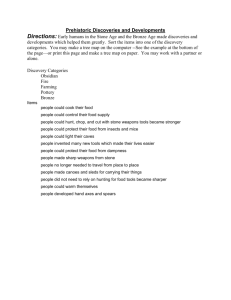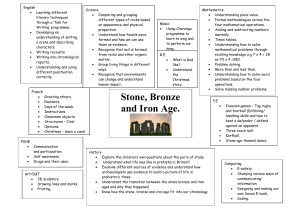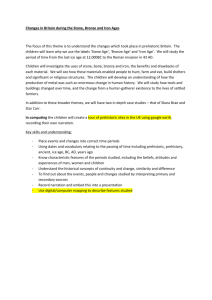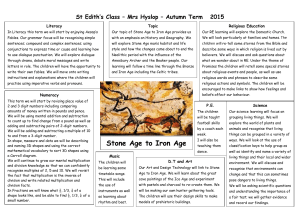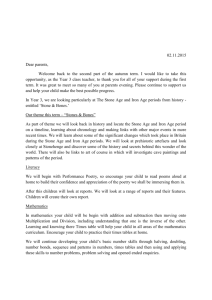Fundamentals of Technology
advertisement
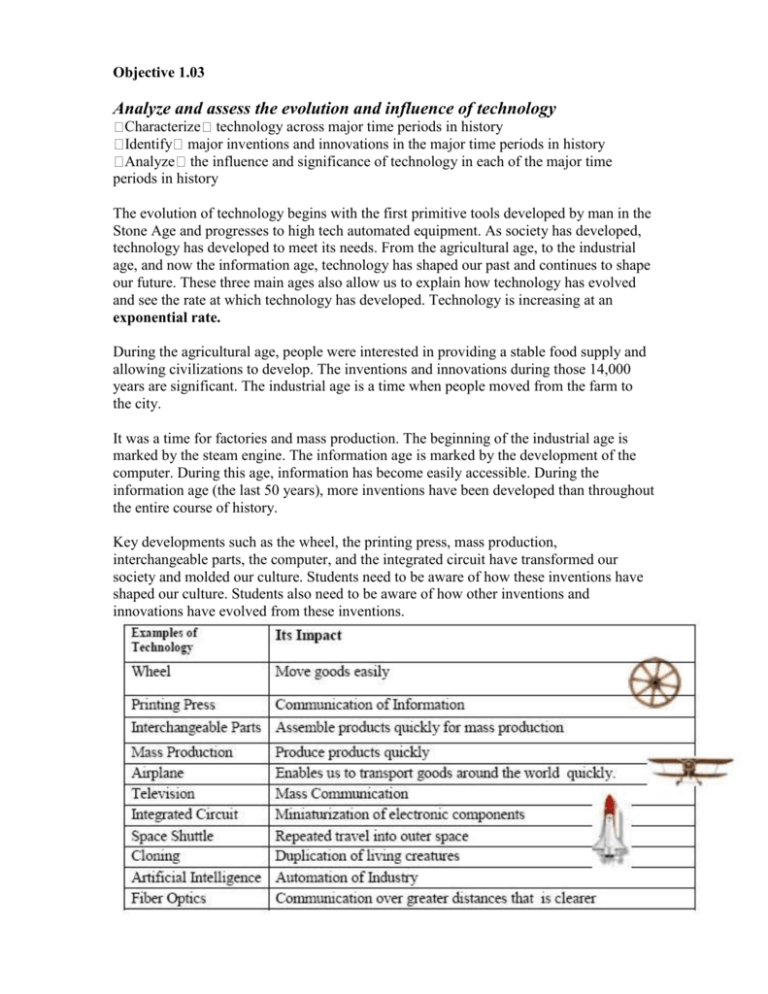
Objective 1.03 Analyze and assess the evolution and influence of technology Characterize technology across major time periods in history Identify major inventions and innovations in the major time periods in history Analyze the influence and significance of technology in each of the major time periods in history The evolution of technology begins with the first primitive tools developed by man in the Stone Age and progresses to high tech automated equipment. As society has developed, technology has developed to meet its needs. From the agricultural age, to the industrial age, and now the information age, technology has shaped our past and continues to shape our future. These three main ages also allow us to explain how technology has evolved and see the rate at which technology has developed. Technology is increasing at an exponential rate. During the agricultural age, people were interested in providing a stable food supply and allowing civilizations to develop. The inventions and innovations during those 14,000 years are significant. The industrial age is a time when people moved from the farm to the city. It was a time for factories and mass production. The beginning of the industrial age is marked by the steam engine. The information age is marked by the development of the computer. During this age, information has become easily accessible. During the information age (the last 50 years), more inventions have been developed than throughout the entire course of history. Key developments such as the wheel, the printing press, mass production, interchangeable parts, the computer, and the integrated circuit have transformed our society and molded our culture. Students need to be aware of how these inventions have shaped our culture. Students also need to be aware of how other inventions and innovations have evolved from these inventions. When one looks throughout history, he/she can see how specific inventions/innovations have transformed history. For example, the Stone Age was a time for survival. Tools were made of stone and used for cutting, hunting, pounding vegetables, and even progressed to harnessing fire. In turn, the tools made it easier to survive. During the Iron Age, many people began to move from farms to develop towns and cities. Tools were made of iron and steel; developments such as the plow and irrigation enabled fewer farmers to grow more food. The Middle Ages brought about the development of paper money, the waterwheel, the magnetic compass, and the printing press. These developments allowed people to trade, travel and spread information easier. The Renaissance was a time for rebirth of the arts and humanities. Leonardo da Vinci created drawings and written descriptions of things that were later developed in the 20th Century. The first screwdriver was invented as gunsmiths tried to adjust their gun mechanisms. The camera obsura, telescope, the submarine, and hydraulic press were also developed during this time period. Throughout the Agricultural Age, jobs were very labor intensive. With the mechanization of the farm, labor was freed up for work in the factories. This caused people to move into the cities. The Industrial Age was a remarkable time. With the mechanization of the farm and invention of the steam engine, industry began to play a major role in society; this marked the beginning of the Industrial Age. Eli Whitney’s interchangeable parts and Henry Ford’s movable conveyor in factories allowed us to produce products more quickly and efficiently. The steam engine, gasoline and diesel engine, airplanes, telephones, telegraphs, and radios were all developed during this age. These products gave people more leisure time and children more time to spend in school instead of on the farm. The Information Age emphasizes processing and exchanging information. “The development of binary language, transistors, microchips, and ENIAC led to an explosion of computers, calculators and communication processes to quickly move information form place to place” (R1, pg. 87). This age is also known for the hydrogen bomb, space shuttles, communication satellites, prefabrication, biotechnology, freeze drying, and the International Space Station. The Information Age has placed knowledge and information at the touch of a button. Roughly speaking, the Information Age spans from the 1950s to the present. It has allowed people to communicate all over the world and in space instantaneously. It has also allowed us to travel outside our world and develop other environments in space. Major Historical Developments Stone Age Approximately 250,000 B.C.- 3,000 B.C. During the Stone Age most tools were made of stone. Shaping rocks into sharp edges for arrows, spears, and knifes was very time consuming and the tools would easily wear with use. Most tools were used for agriculture and hunting. Bronze Age Approximately 3000 B.C. - 1200 B.C. Bronze is a metal alloy made of copper and tin. People found it easier to shape tools if metal was melted then shaped by using a mold. The metal tools were not only easier to shape, but were more durable and useful than stone tools. Most technological developments were for improved agriculture practices, growing industries and military applications. Iron Age Approximately 1200 B.C. - 500 A.D. Iron is metal, and when alloyed with other materials is stronger than bronze. Again, most technological developments were brought about to improve agriculture, trade and military weapons. Middle Ages Approximately 500 A.D. - 1500 A.D. The Middle Ages brought about a number of technological developments that led to industrialization. The agricultural advances produced a surplus of crops, which led to increased trade. Increased trade created bigger markets with more products. The spinning wheel was one of the jumpstarts of a growing textile industry. Renaissance Approximately 1450 A.D -1700 A. D. the Renaissance was a time of rebirth in the arts. Gutenburg invented the printing press with moveable type, which enabled information to be disseminated throughout the world. At first, the printing press was used for the distribution of the Bible, but as time progressed, it was used to produce other literature. Leonardo da Vinci created drawings and written descriptions of things that were later developed in the 20th Century. The first screwdriver was invented as gunsmiths tried to adjust their gun mechanisms. The camera obscura, telescope, the submarine, and hydraulic press were also developed during this time period. Industrial Age Approximately 1700 - 1940. The Industrial Age marks the point in history in which factories took over the production of most products. People began to buy items and migrate toward cities for jobs. The growing number of factories drove the need for technological improvements in machinery and systems. Trade over long distances increased which created a bigger demand for fast, reliable, efficient transportation systems. Communication advances accelerated information and coordination systems at an alarming rate. Structural systems were forced to improve as cities began to grow up instead of out. Information Age Approximately 1940 - present. The Information Age is a period of time where technological developments have and will continue to occur at an exponential rate. New developments are often outdated before the finished product arrives at the store for purchase. The microchip revolutionized the world of electronics and has made communication systems faster, cheaper, and more powerful than ever. Constant research occurs in energy systems to make them more efficient and less harmful to the environment. Manufacturing systems are highly technical and require specialized education. Structural systems are constantly changing to incorporate new materials and creative approaches to efficient building. Stone Age 250,000 B.C. - 2500 B.C. Development Approximate Date Significance Control of fire 500,000 B.C. Cooking, making pottery, lighting, heat Hand ax 500,000 B.C. Used for hunting Bow and arrow Unknown Used for hunting Spears Unknown Flint rock or bone and used for hunting and fishing Animal oil lamps Unknown Lamps that burn on animal fat Needles 18,000 B.C. Made of bone to produce clothing Agriculture 8000 B.C. Humans planned the growth of plants and animals for food Bricks 7000 B.C. Building materials Irrigation 5000 B.C. Humans planned the watering of agricultural crops Wheel 3500 B.C. Increased human power for agriculture and transportation of goods Bronze Age 3000 B.C. - 1200 B.C. Development Approximate Date Significance Wooden ships 3000 B.C. Used for trade and transportation Pyramids 2700 B.C. Remarkable applications of architecture and mathematics Improved wheels 2000 B.C. Spokes made wheels lighter, thus easier to transport goods. Chariots 2000 B.C. Ground transportation and military vehicles Glass 2000 B.C. Used for jewelry and ornaments Casting of metals 1400 B.C. Pouring hot metals in a mold to form shapes Iron Age 1200 B.C. - 500 A.D. Development Approximate Date Significance Alphabet 1000 B.C. Important for communication and trade Arabic Numbers 800 B.C. Important for communication and trade Water Wheel 700 B.C. Grind grains such as corn Spinning wheel 500 B.C. Used to make yarn and thread for cloth Great Wall of China 221 B.C. Built to prevent invasion Glass blowing 100 B.C. Easier to shape glass Calendar 45 B.C. Important for communication, trade and agriculture Glass 50 A.D. First used in windows Cement 400 A.D. Used as a building material Middle Ages 500 A.D. - 1450 A.D. Development Approximate Date Significance Windmills 600 Used to pump water for irrigation and milling grain Rockets 1232 Used as a military Gunpowder 1242 First explosive with both military and building uses Renaissance 1450 A.D -1700 A. D. (Approximately) Development Approximate Date Significance Leonardo da Vinci 1452 – 1519 Designed flying machines, helicopter, machine gun, turbines, etc… Printing press 1454 Improved communication through the mass production of books Railroad 1500 Used in mining to transport heavy loads Galileo 1596 – 1610 Heat measurement, laws of gravitation, observed the solar system Newton 1600s Laws of gravitation, optics, and physics Industrial Age 1700 - 1940 Development Approximate Date Significance Factory system 1700's Mass production of products Steam engine 1769 Changes steam into mechanical energy to operate machines Cotton gin 1793 Made cotton a profitable industry Machine tools 1795 Made it possible to produce precision parts for manufacturing Erie Canal 1825 Opened shipping routes between the Great Lakes & Atlantic Ocean Telegraph 1837 Improved long distance communications Transcontinental 1869 Fast, reliable transportation for people and goods Railroad Suez Canal 1869 Shortened shipping routes between east and west Africa Telephone 1877 Improved communications without the use of coded messages Phonograph 1877 Recording device Radio 1895 Long distance (transatlantic) voice communications Airplane 1903 Greatly improved long distance transportation of people/goods Information Age 1940 - Present Development Approximate Date Significance Television 1923 Fast visual communications Computer 1940s Facilitates the processing & control capabilities of people Geodesic dome 1947 Structure of lightweight materials without reinforcing members Transistor 1948 Smaller and more reliable than vacuum tube Space exploration 1950s Responsible for countless technological advances through research Integrated circuit 1959 Contains thousands of components that are cheap and efficient Facsimile 1970s Transmits documents over telephone lines Cellular telephone 1978 Mobile telephone communications Internet 1984 Individual access to enormous quantities of information Fiber optics 1980s Fast, frictionless communications through a glass tube Solar energy Undefined Converting energy from the sun for use in modern energy systems Nuclear reactors 1980s Alternative sources of energy Related VoCATS Test Items 1. What invention has enabled weather forecasters to monitor weather patterns more efficiently ? A. Doppler Radar B. Global Positioning System C. Television D. Sonar 2. The invention of the wheel improved: A. Communication B. Construction C. Transportation D. Manufacturing 3. The invention of the printing press improved: A. Communication B. Construction C. Transportation D. Manufacturing 4. In 1995, 16 MBs of RAM was standard on a top of the line computer. In 2000, 128 MBs of RAM is standard on most computers. This is an example of: A. Exponential Growth B. Linear Growth C. Direct Growth D. Explosive Growth 5. The mechanization of the farm and invention of the steam engine marks the beginning of the what age ? A. Agricultural B. Industrial C. Technological D. Information 6. This age emphasizes processing and exchanging information. A. Communication B. Technology C. Industrial D. Information 7. We are able to reduce the negative impacts on the environment and other technologies when the needs of technological innovations are balanced with the: A. Environment B. Society C. Culture D. Politics 8. During what age did people move from the farm to the city? A. Industrial B. Technological C. Information D. Agricultural 9. What age are we living in? A. Agricultural B. Industrial C. Information D. Technological 10. What invention led to the mass production of written material? A. Alphabet B. Typewriter C. Internet D. Printing Press 11. What age accounts for the most technological developments? A. Stone Age B. Middle Age C. Information Age D. Industrial Age 12. What age accounts for the fewest technological developments? A. Stone Age B. Renaissance C. Industrial Age D. Information Age 13. During the Bronze Age, the wheel was improved by using spokes. What is most significant about the improved wheel? A. Smoother B. Cheaper C. Heavier D. Lighter 14. During the Iron Age, water wheels were used to: A. generated electric power B. made it possible to produce copper C. saw lumber D. grind grain 15. What is the most significant technological development thus far in the Information Age? A. Television B. Cellular phone C. Internet D. Integrated circuit 16. During the Industrial Age, Samuel Morse invented the telegraph. What was most significant about the telegraph? A. Enabled faster communications over long distances B. Enabled music groups to record songs C. Assisted in air traffic control D. Paved the way for rural access to the Internet 17. Agriculture and irrigation were first developed in what age? A. Bronze Age B. Stone Age C. Iron Age D. Industrial Age 18. During the Stone Age, tool use was limited to: A. Agricultural practice. B. Military application. C. Hunting and agricultural practice. D. Industrial use. 19. Pyramids are examples of architectural and construction techniques used in which age? A. Stone Age B. Bronze Age C. Middle Age D. Iron Age 20. Mass production in a factory system first occurred during the: A. Iron Age. B. Industrial Age. C. Middle Age. D. Information Age. 21. Canal building dramatically improved shipping routes during the: A. Iron Age. B. Information Age. C. Industrial Age. D. Middle Age. 22. Major migration toward cities began during the: A. Middle Age. B. Information Age. C. Industrial Age. D. Iron Age. 23. In the Bronze Age, glass was used for jewelry and ornamentation. In the Information Age its use has enhanced: A. Construction B. Transportation. C. Irrigation devices. D. Communication 24. In the Iron Age, a significance development in communication was the: A. Printing press. B. Alphabet. C. Telegraph. D. Spoken language. 25. The military use of rockets and gun powder first occurred during the: A. Industrial Age. B. Middle Age. C. Iron Age. D. Information Age. 26. The industrial age is characterized by: A. solar power B. nuclear power C. animal power D. steam power 27. During the industrial age, factory growth led people to: A. trade B. barter C. migrates to cities for jobs. D. creates demands. 28. Which of the following are used in monitoring the aspects of technology related to our environment? A. Doppler radar and weather satellites B. Television, Internet, and news broadcast C. Computer and global positioning systems D. Divining rod and intuition 29. In what age, did the influence of technology make technological obsolescence a factor? A. Renaissance B. Stone C. Industrial D. Information

